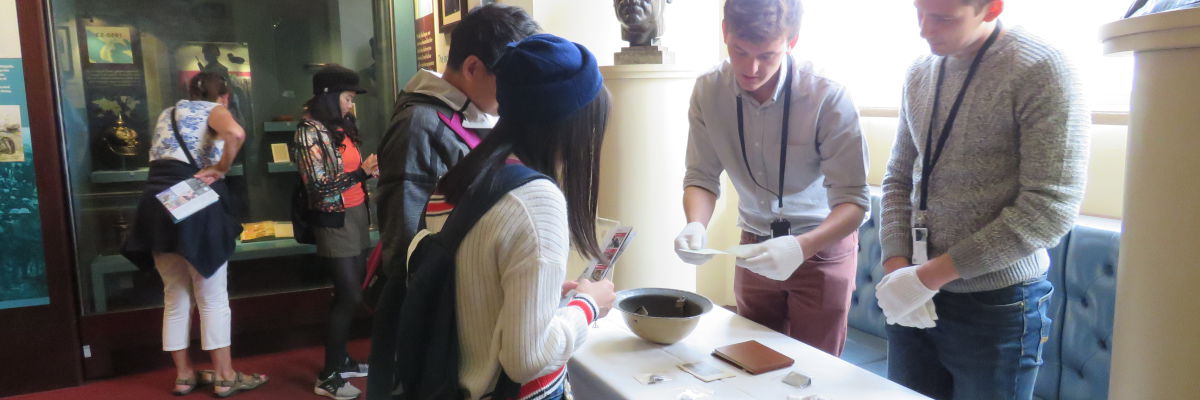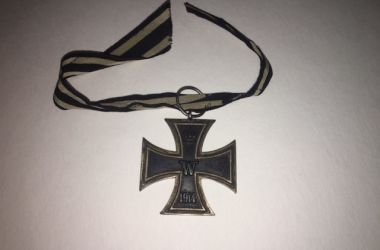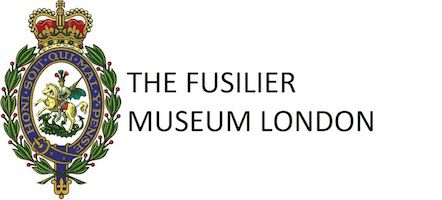 This August, the Fusilier Museum began conducting object handling sessions which have been popular with visitors to the Tower of London passing through the museum. Most museums can only display a fraction of the objects in their collections, the Fusilier Museum is no different. Object handling sessions are a fantastic opportunity to get up close and personal with some of the other fantastic objects not usually on display!
This August, the Fusilier Museum began conducting object handling sessions which have been popular with visitors to the Tower of London passing through the museum. Most museums can only display a fraction of the objects in their collections, the Fusilier Museum is no different. Object handling sessions are a fantastic opportunity to get up close and personal with some of the other fantastic objects not usually on display!
 Most recently, we have enjoyed connecting visitors with the experiences of First World War soldiers. Whether through the intricate design of a Sweetheart Brooch or a one of a kind piece of Trench Art, we are passionate about the power of objects in narrating valuable human stories that change perspectives and lives. One object that has received a lot of interest during the sessions is our German Iron Cross which closely resembles the British Victoria Crosses on display in the medal gallery. The Iron Cross was originally Prussian, being founded in 1813 as a result of the Napoleonic Wars to reward soldiers for their bravery. Following the unification of Germany in 1871, the award could be given to all soldiers in the German army. Divided into three classes, soldiers could only receive the 1st class medal after receiving the 2nd. Meanwhile the Grand Cross was reserved for victorious generals. This example of a 2nd class Iron Cross was most likely captured by a Royal Fusilier in the British Army during the First World War.
Most recently, we have enjoyed connecting visitors with the experiences of First World War soldiers. Whether through the intricate design of a Sweetheart Brooch or a one of a kind piece of Trench Art, we are passionate about the power of objects in narrating valuable human stories that change perspectives and lives. One object that has received a lot of interest during the sessions is our German Iron Cross which closely resembles the British Victoria Crosses on display in the medal gallery. The Iron Cross was originally Prussian, being founded in 1813 as a result of the Napoleonic Wars to reward soldiers for their bravery. Following the unification of Germany in 1871, the award could be given to all soldiers in the German army. Divided into three classes, soldiers could only receive the 1st class medal after receiving the 2nd. Meanwhile the Grand Cross was reserved for victorious generals. This example of a 2nd class Iron Cross was most likely captured by a Royal Fusilier in the British Army during the First World War.

 Another object in our collection depicting the 2nd class Iron Cross is a piece of trench art. ‘trench art’ is name given to military items such as a bullet that has been altered or repurposed as a unique art piece often personal to the individual who created it. Our objects are a simple match box cover from First World War, which has been painstakingly detailed with the design of this medal. On the reverse is an image of a German soldier wearing the infamous Stahlhelm (steel helmet) similarly punched in with perhaps the tip of a trenching tool or bayonet. You can check out an example of a German Stahlhelm within our galleries.
Another object in our collection depicting the 2nd class Iron Cross is a piece of trench art. ‘trench art’ is name given to military items such as a bullet that has been altered or repurposed as a unique art piece often personal to the individual who created it. Our objects are a simple match box cover from First World War, which has been painstakingly detailed with the design of this medal. On the reverse is an image of a German soldier wearing the infamous Stahlhelm (steel helmet) similarly punched in with perhaps the tip of a trenching tool or bayonet. You can check out an example of a German Stahlhelm within our galleries.

At our last object handling session, there was lots of interest in our ‘Brodie’ Helmet, which became standard issue for British soldiers on the Western Front in 1916. Some of the great questions we were asked were “How heavy is it?” “Can it stop a bullet?” and even “Can I try it on!”. Cast from a single sheet of steel and designed by John Leopold Brodie, the helmet was easily produced and helped reduce head injuries by 75%*. It was still used in WW2, which is where this example is from.
We’ve got lots of other objects we’re excited to share with visitors. You can’t miss us down in the gallery, we’re under the watchful gaze of two large busts of Adolf Hitler and Benito Mussolini, found by Fusiliers in post-war Iserlohn, Germany and captured during the allied advance to liberate Rome respectively. Between the pillars of fascism as we call it! Pop on some gloves and join us next Monday from 2:30pm to 4pm in the main gallery to pick up and closely examine more interesting objects from the museum’s stores!

*Stated in the WW1 galleries at IWM London.
Blog written by David and Paul, Research Volunteers at the Fusilier Museum London
